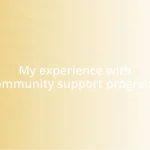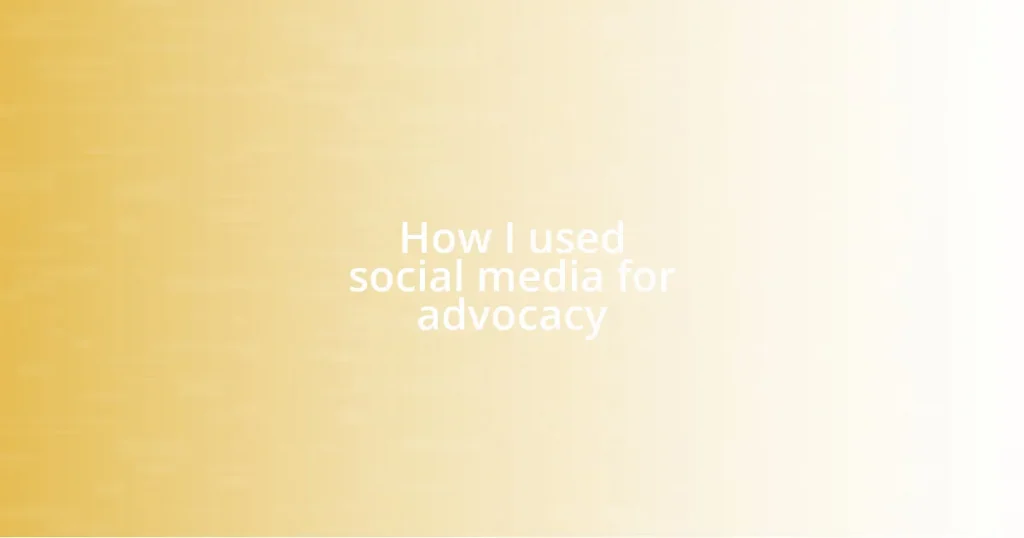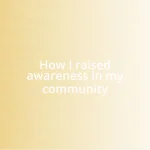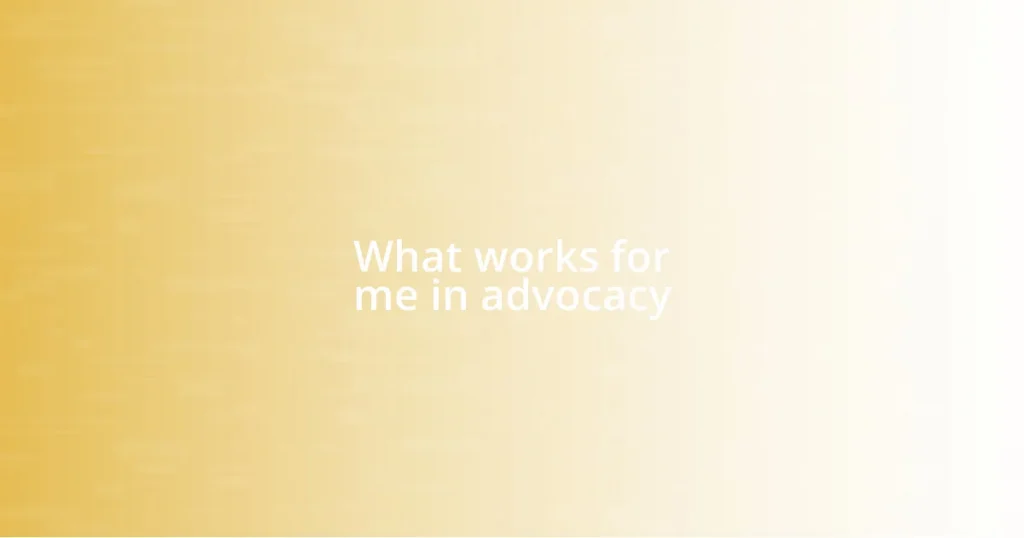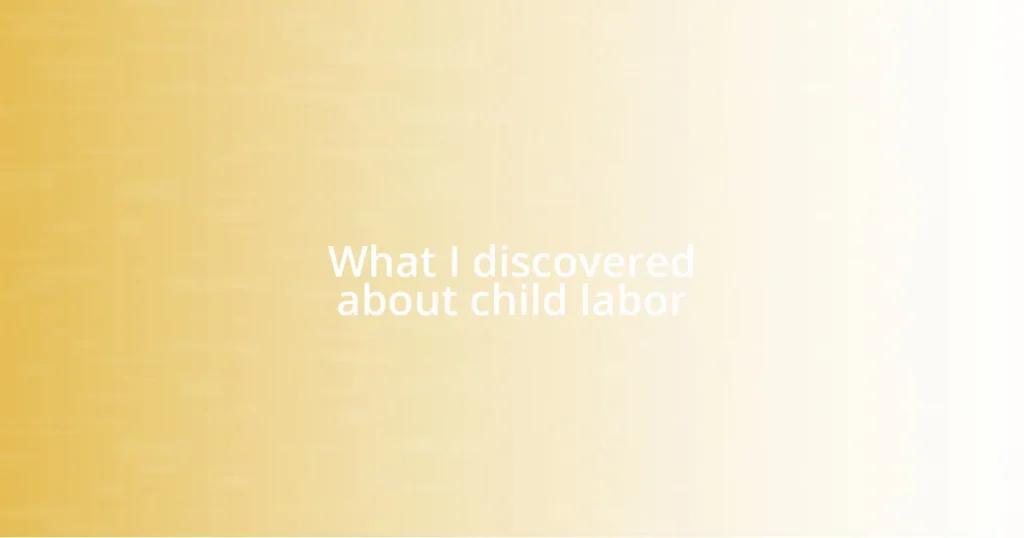Key takeaways:
- Identify specific advocacy goals to channel efforts effectively and connect with like-minded individuals.
- Craft your advocacy message with authenticity, focusing on your audience and using emotional appeal to inspire action.
- Engage your online community through storytelling, regular discussions, and collaborations to foster meaningful connections.
- Measure success through both qualitative feedback and tangible actions to adapt strategies and enhance advocacy efforts.

Identifying Your Advocacy Goals
Identifying your advocacy goals is the first step toward making a meaningful impact. I remember when I realized I needed to prioritize my focus; it was after a pivotal conversation with a friend about environmental issues that struck a chord with me. That moment made me think: what change do I genuinely want to see in the world?
After pinpointing my passion, I found a clearer direction to channel my efforts. For example, I decided to advocate for local clean-up initiatives instead of spreading myself too thin trying to address every environmental issue out there. This specific goal not only fueled my enthusiasm but also connected me with a community of like-minded individuals who were equally passionate about the cause, making my journey even more fulfilling.
Thinking about your own interests, what specific issues resonate deeply with you? I encourage you to reflect on moments that stirred emotions within you—those moments can guide you toward discovering your unique advocacy goals. Transforming your feelings into action is incredibly powerful, and it starts with clarity in what you truly care about.

Crafting Your Advocacy Message
Crafting your advocacy message is all about authenticity and clarity. I vividly remember when I started formulating my message for a social media campaign. I wanted to ensure my words truly reflected my passion for environmental conservation. I often asked myself: what story am I telling, and who is my audience? By reflecting on my personal experiences, I was able to communicate in a way that resonated deeply with my followers.
Here’s a quick checklist to help you craft your own advocacy message:
- Know your audience: Understand who you’re speaking to and what matters to them.
- Be personal: Share your own experiences; they create a genuine connection.
- Stick to your core message: Keep it focused and consistent to avoid confusion.
- Use emotional appeal: Engage emotions; share stories that elicit empathy or inspire action.
- Call to action: Clearly indicate what you want your audience to do after engaging with your message.
Taking the time to reflect on these elements made a significant difference in how I conveyed my message, leading to more meaningful interactions and greater engagement for my cause.

Building an Engaging Online Community
Building an engaging online community requires intentional effort and a touch of heart. I recall diving into a Facebook group focused on sustainability; at first, I was a silent observer. It was the stories that members shared—like a woman who transformed her garden into a butterfly sanctuary—that inspired me to participate. I started sharing my own tips on sustainable living, and over time, I noticed how these conversations sparked real relationships. Engaging with others not only made me feel connected but also energized me to advocate more passionately.
Creating a sense of belonging is crucial in any community-building endeavor. One strategy I found effective was hosting regular online discussions. I would set a specific day each month to chat about topics like waste reduction or renewable energy, encouraging members to share their experiences. I often felt nervous before these sessions, but once they started, the warmth and enthusiasm from participants reassured me. Seeing others share their triumphs, along with their struggles, reinforced the importance of support in advocacy.
In my experience, authentic engagement often leads to unexpected collaborations. For instance, through a spirited discussion about plastic-free living, I met someone who organized local clean-up events. Together, we pooled our resources and led a community clean-up day, which not only enhanced visibility for both our causes but also fostered a deeper connection between our followers. This synergy highlighted how relationships can amplify advocacy efforts in delightful and unanticipated ways.
| Community Engagement Strategies | Your Experience |
|---|---|
| Storytelling | Sharing personal stories can create emotional bonds. |
| Regular Discussions | Scheduled chats help maintain connection and engagement. |
| Collaboration | Working together can amplify your advocacy message. |

Creating Impactful Visual Content
Creating compelling visual content can elevate your advocacy message to new heights. I remember a project where I crafted a series of infographics detailing the impact of air pollution on health. Those visuals didn’t just present data; they told a story through vibrant colors and clear, accessible information. I often wonder: how can something so simple, like a well-designed graphic, evoke such strong emotions and spur action? The right visuals can inspire people to share your message far beyond your usual reach.
In my experience, utilizing user-generated content can add authenticity to your campaign. I encouraged followers to share photos of their sustainable practices and tagged my campaign with a specific hashtag. The moment I saw a collage of these images come together, it struck me how powerful collective storytelling can be. It wasn’t just me advocating anymore; it was a community showcasing their commitment. How incredible is it to think that every photo shared not only amplifies our voices but creates a tapestry of hope and action?
Never underestimate the importance of video content in capturing attention. I’ve created short clips that range from educational videos about recycling to personal testimonies from community members affected by environmental issues. When I posted a heartfelt video of a local family discussing their plastic-free journey, I felt compelled to respond to every comment, as the video sparked sincere conversations. Isn’t it amazing how a few minutes of footage can bridge the gap between strangers and inspire a communal push for change? Visual content has the unique ability to forge connections that words alone sometimes cannot achieve.

Measuring Your Advocacy Success
Measuring the success of your advocacy efforts can feel daunting but worthwhile. I remember a campaign where I aimed to promote local recycling initiatives. Instead of just looking at likes and shares, I decided to track how many people signed up for clean-up days and recycling workshops. It was exhilarating to see participation grow, turning my online interactions into tangible actions that directly benefitted the community.
I’ve found that qualitative feedback is equally important as numbers. After one of my workshops, a participant shared with me how that brief conversation about reducing plastic changed her household’s habits. Moments like that remind me why I started advocating in the first place. It’s not just about metrics; it’s about making heartfelt connections that inspire change in people’s lives. Wouldn’t it be amazing to think that your efforts could ripple out and impact someone’s daily routine?
With each new campaign, I always set clear goals and revisit them regularly. I’ve learned to adapt my strategies based on what resonates most with my audience. If a specific post generated a lot of discussions, I’d dive deeper into that topic. I continue to ask myself: how can I engage my community even further? The beauty is that by embracing both successes and setbacks, I keep refining my approach, ultimately creating a more robust advocacy foundation.

Adapting Strategies Based on Feedback
Feedback is a powerful tool in shaping advocacy strategies. I recall a time when I shared a post about climate change, only to receive mixed reactions. At first, I felt disheartened, but then I opened myself up to understanding those differing perspectives. By asking questions and engaging with my audience, I realized that people were more concerned about local effects rather than global statistics. Recognizing this shift allowed me to tailor my messaging to focus on community-specific issues, making my advocacy much more resonant.
Listening to my audience has transformed my approach significantly. I remember a poll I conducted to gauge interest in various environmental topics. The results showed a surprising passion for urban gardening, which I hadn’t expected. I decided to pivot my content strategy and produced a series of posts dedicated to this theme. Seeing the enthusiasm and engagement from my followers was incredibly rewarding. It made me ponder: how often do we miss opportunities simply because we aren’t attuned to our audience’s interests?
Adjusting my advocacy strategies based on feedback has not only improved my reach but also deepened my connection with the community. After incorporating suggestions from fellow advocates about collaborative events, I hosted a joint cleanup day. The turnout exceeded my expectations, and those personal interactions reaffirmed my belief in the power of collaboration. Isn’t it fascinating how being attentive and adaptable can turn feedback into fuel for meaningful change?






